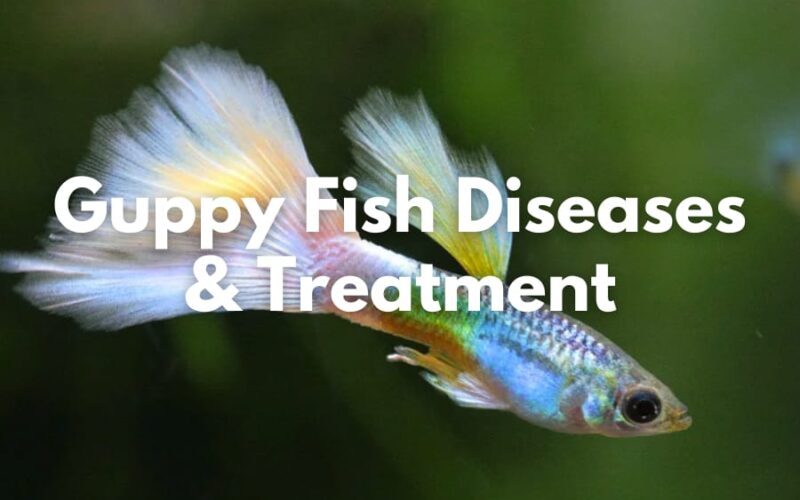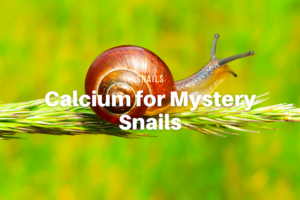Fish are relatively easy to take care of, and therefore it is one of many animals that is usually kept as a house pet.
As long as you feed them and clean their tank regularly, they should be able to live long and even reproduce. One of the easiest fishes to keep is Guppy fish.
Guppy is considered a popular aquarium fish due to its small size, cute color, and peaceful nature. They are the most widely distributed tropical fish in the world. That is why these fish are relatively easy to find in the local pet store.
Guppy or also known as rainbow fish or millionfish, originated from South America. However, these fish have been introduced to a variety of different environments with different ecological conditions.
Thanks to their high adaptability, these fish can survive. That is one of the reasons why Guppies are now available in many other parts of the world.
There are around 300 varieties of Guppies known with different tail shapes, sizes, and colors. These varieties of colors are what make a school of Guppies looks beautiful in an aquarium.
Guppies are active fish and social fish that likes to be kept in a tight group. They are also highly active and will move around all the time. Therefore, if you’re planning to keep Guppy fish as a pet, don’t just get one fish, but get some of them in an aquarium.
Read also: Getting to know Guppy fish eggs
Taking care of guppy fish is easy; as long as you provide them with high water quality, a good food diet, and regular aquarium maintenance, you can keep your fish alive for longer. However, it is important to note that various diseases can affect guppies.
In this article, we are going to discuss various guppy diseases and how to treat them.
Understand Various Guppy Diseases and How to Treat Guppy Fish Diseases
As mentioned previously, the guppy is a highly adaptable fish and relatively easy to take care of. However, it does not mean that this fish will never get sick or infected by the disease.
There are quite a few diseases that can affect these fish and even can kill them or infect other guppies in the same tank if it is not treated properly.
Fortunately, many of these guppy fish diseases are treatable. Here are some common guppy diseases and how to treat them back to health.
1. Stress
New pets are prone to stress, including fish. Most guppy diseases are usually caused by stress which can weaken their immune system. This weakened immune makes them more vulnerable to diseases caused by parasites and infections.
Many things can cause stress in guppies, such as bad habitat, overcrowded fish tanks, bad water quality, wrong pH range, and wrong temperature.
Therefore, it is important to understand a good fish tank environment for your guppies to keep them healthy all the time.
2. White Spots or Ick
White spots are one of the most common guppy diseases. It is caused by a parasite and not deadly when treated properly. The symptoms include small white spots on the skin and fins, lose appetite, and fish keep rubbing their skin to anything inside the aquarium such as rocks, plant leaves, decorations, etc.
When you see your guppies are showing these symptoms, it is better to start treatment immediately. Here are a few steps you can do to treat white spots or ick in guppy fish.
- Gradually raise the water temperature to 80 degrees Fahrenheit.
- Add ick medication products into the aquarium, such as Seachem Paraguard.
- Add one teaspoon per gallon water of aquarium salt for around 4 to 7 days.
- Finally, decrease the water temperature gradually to normal.
- Change 70% of the water.
3. Columnaris and Mouth Fungus
Columnaris and Mouth Fungusp in guppy fish is caused by bacteria formed on the fish’s mouth or around the body’s middle part. It usually appears as a big white splash around these areas and can slowly paralyze the guppies’ muscles.
That is why guppies with this disease will usually also show symptoms of trouble swimming. They will also show signs of losing appetite.
When you see these symptoms on your guppies, it is important to start treatment immediately. This guppy disease is highly contagious, and you don’t want it to infect other fishes in your fish tank and kill all of the colonies in it.
Also read: Why fish keeps opening their mouth?
Here are some steps to follow to treat Columnaris and mouth fungus in guppy fish:
- You can use Maracyn antibiotic or Formalin to cure this disease.
- Change 50% of the tank water, then add salt one teaspoon of salt per gallon of water to your fish tank every three days.
- Leave the salt in the water until you see the signs are improved. Then, change 50% – 70% of the water in the tank.
- You can also use potassium permanganate (KMnO4) to treat Columnaris. However, it is important to note that don’t put your fish for more than 30 minutes in the water with this chemical in it. It also should not be more than 10mg per liter. Potassium permanganate is a powerful substance that can cause a severe burn on your fish.
Mouth Fungus disease is preventable as long as you keep good maintaining habits for your fish tank. Do not overcrowd your fish tank, regularly change the water, add adequate filtration, and ensure that you provide good water movement and aeration in your aquarium.
4. Red Blood Spot
This guppy disease usually occurs in new aquariums that have not been cycled yet. It is caused by ammonia or nitrites poisoning, making red blood spots appear on the stomach or body of your guppies.
Red blood spots on guppies cannot be treated, but you can save them if the poisoning level is low, and you immediately act by putting your fish in a fully cycled fish tank.
Do not immediately introduce fish into a new aquarium because the ammonia and nitrite level will most likely quickly increase. That is because there are not enough good bacteria that can transform these substances into nitrates.
Set aside your aquarium to cycle for at least two weeks or six weeks. Then, measure the ammonia, nitrite, and nitrate levels using a measurement kit. The safe amount would be 0 ppm ammonia, 0 ppm nitrite, and 10-40 ppm nitrate.
Change the water frequently, and you may need to change the water more than once a week for a new aquarium. It would be best to reduce feeding or skip feeding for a day to prevent ammonia build-up in your fish tank.
You can also add live plants inside your aquarium, which will help absorb excess ammonia in the water.
5. Rotting Fin and Tail
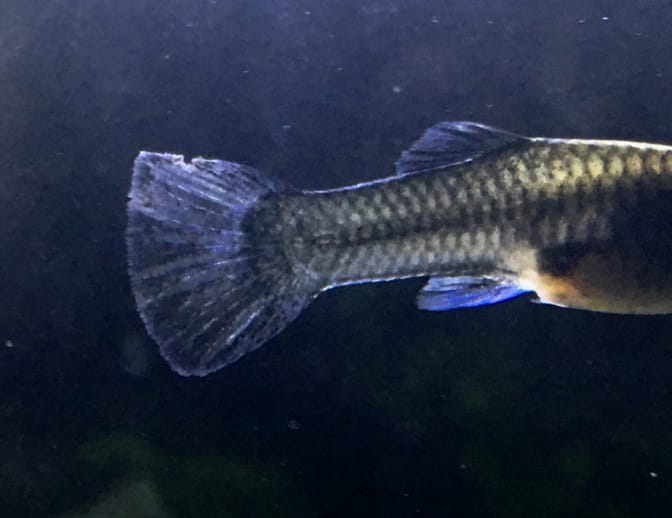
There are various reasons why your guppies show signs of rotting fin and tail. Some of them are bacterial infection, fungus growth, poor water quality, and ammonia burns.
Watch signs of tail and fins that look like it is stuck together. It is a sign of a rotting fin and tail.
Since there are a few different reasons why this problem occurs, there are various ways to cure them. Here are some steps you can do to cure a fish with a rotting fin and tail.
- Separate your sick fish into a different tank before treating it because you don’t want your healthy fish exposed to unnecessary medication.
- Before treating the sick fish, make sure you clean the aquarium beforehand and remove any chemical filtration.
- For bacterial infection, you can add antibiotics to the fish. Some of the recommended antibiotics are Maracyn, Maracyn 2, Tetracycline, or Seachem ParaGuard.
- For fungal infections, please treat them with specific anti-fungal medication. You can use a combination of Maracyn and Ich-X.
- For ammonia burns, you only need to change the water with higher water quality for your guppies.
Remember that even when you see that the rotting signs have disappeared, make sure to continue the medication for at least five days to one week.
It is because sometimes the diseases are still in their system despite no rotting signs showing anymore. You want the disease to be completely cured before putting your now healthy fish back to its original tank.
6. Swim Bladder Disorder
The swim bladder is an important organ in a fish body that controls its buoyancy and keeps its balance while swimming. This condition is not quite common in guppy fish.
However, if your guppies are experiencing this condition, it may be due to high stress because they are moved from shallow to deep water.
When this happens, the sick fish will appear floating at an angle or upside down. They will not be able to control the swimming or keep their balance while swimming. In addition to high stress, ammonia poisoning may also cause this problem in guppies.
7. Swim Bladder Inflammation
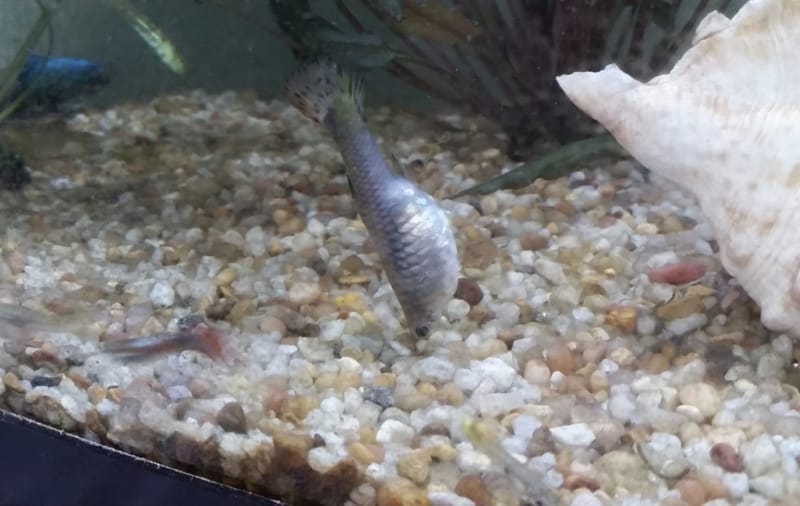
Another guppy fish disease that infects the swim bladder is swim bladder inflammation. This disease is easy to recognize since the belly will look distended, and they will swim downward with their heads facing down.
Although this disease is easy to spot, unfortunately, it cannot be cured. Fish that shows these symptoms should be removed and destroyed right away.
8. Velvet or Odinium
This disease is almost similar to ick. However, it shows tiny gold-colored spots instead.
Velvet is highly contagious and difficult to spot at an early stage due to the tiny spots. This disease can be deadly to guppy, especially because it is hard to spot earlier.
Guppy owners usually realize this disease when their fish already shows signs of peeling off skins and bleeding. When your fish shows these signs, it is important to treat it immediately with the following steps:
- Add copper medications such as Seachem Cupramine to your aquarium.
- Turn off your aquarium’s lights until the disease is completely cured.
- Change 70% – 90% of your aquarium water once the symptoms are gone.
When you use copper to treat guppy diseases, remember that this substance is deadly to shrimps and snails. Therefore, if your aquarium consists of these two animals, make sure to separate them from the fish beforehand.
It is also important to note that copper residue will remain in the tank since it cannot be washed out. Therefore, you will no longer be able to put your snails and shrimps back to that tank.
9. Viral Haemorrhagic Septicaemia (VHS)
Viral Haemorrhagic Septicaemia or VHS is caused by a virus that infects the blood in guppy fish. Signs of this guppy disease include pale gills, eye-bulging, lesions on the body, ulcers, and sores that develop after the lesions, and then the fins start to rot.
Finally, the fish will get darker and stop eating.
This condition can be treated with the Maracyn 2 antibiotic. Another important step that you need to do is perform huge water changes after the treatment is done.
10. Camallanus Internal Worm
This worm is one of the most common parasites in guppies. This worm will stick out from the anus and can reach up to 2 centimeters. Therefore, it is easy to spot, especially because it is brown or orange and moves just like other worms.
Other fish may usually attack the worms that are sticking out from the fish. However, it is still important to treat them and not just let other fish treat this disease by attacking the worm. Chances are your other fish will get infected too.
There is not enough information on where this parasite came from. However, Camallanus is usually found in guppies that live in ponds and have live Cyclops as food.
Therefore, it is always better to avoid feeding your guppy fish with live Cyclops.
Below are a few steps you can follow to treat Camallanus parasite on your guppy fish:
- To treat this guppy fish disease, you can use Levamisole, Fenbendazole, or Parcide X or D. Use these medications for at least five days.
- Then, vacuum the substrate and perform complete filter cleaning.
- Change 70% to 90% of the water in your aquarium.
- In three weeks, repeat the treatment with the medication above, and then clear the filter and vacuum the substrate again.
When you can spot this parasite early, you can save a lot of your guppy fish and keep them healthy.
11. Swollen Gills
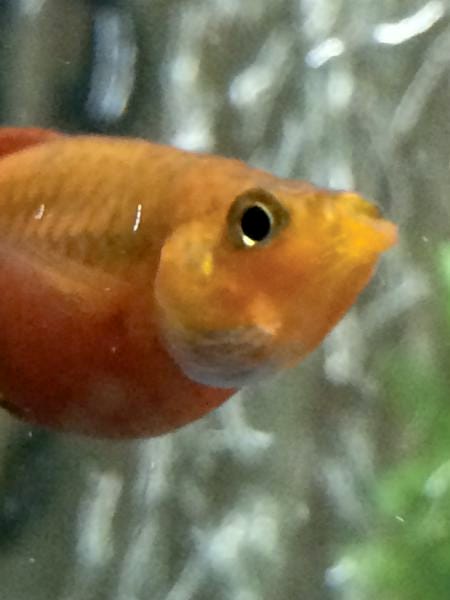
Swollen gills is one of guppy fish disease that is usually caused by ammonia or carbonate poisoning. Ammonia will be formed from decomposing fish food, fish waste, or other organic matter. Meanwhile, Carbonate is usually found in rocks and substrates.
In low quantities, ammonia will burn the gills and make them inflated. Worse, it can be deadly in higher quantities. When their gills are swollen, your guppies will be gasping for air at the surface.
Watch this sign in your guppies and start treatment immediately as follows:
- Change 50% of the water immediately and monitor the water parameter for the next few days.
- Perform an ammonia test to make sure that it is on a safe level.
- Stop feeding the fish for a few days because it will only increase the ammonia at this stage.
- Add nitrifying bacteria to your fish tank.
12. Popped Eyes
A few things can cause popped eyes to guppy fish, from bad water quality, bacterial infection, fungal infection, dropsy, tuberculosis, or other parasites. While this condition will not be deadly to guppy, it can cause blindness.
Since the cause of this condition is not obvious, popped eyes can be difficult to cure. You can start medicating the sick fish with various treatments available for certain conditions mentioned above that may cause this disease.
13. Protozoan Infection
Tiny parasites like protozoa can also infect guppies. These parasites are infecting fishes by attaching themselves to the skin, gradually entering the fish body through muscles, and then reaching the bloodstream.
This disease is a sign that your tank is in poor condition. You can easily prevent this disease by practicing good habits in maintaining your tank.
When your fishes are already infected, here are some steps to follow through to cure them:
- Add a water heater to your fish tank to make sure the water is at a stable temperature.
- Cure the early stage of this disease with Malachite Green or Formalin.
- For advanced stages of diseases, you will need copper medication such as Seachem Cupramine.
- Once the treatment is complete, you need to change 50% to 70% of the tank’s water.
- Finally, make sure always to apply good tank habits to prevent the disease from returning in the future.
14. Gill Flukes and Gill Worms
Just as its name suggests, this disease is caused by worms. The tiny white worm is visible to the naked eye and causes the gills to bleed. Guppy with this disease will appear gasping for air at the surface or sitting still at the bottom.
This problem usually occurs when you mix new fish or plants into the aquarium. To prevent this disease from infecting your fish, ensure the new addition appropriately before mixing them.
This guppy disease can be cured if you can spot them early on. However, as the disease progresses, gill fluke or gill worms can be deadly to your guppy.
When this condition occurs, you cannot treat the sick fish only. Treat the whole aquarium to prevent the worm from infecting other fish. Use special medication to treat this disease properly.
15. Scoliosis or Bent Spine
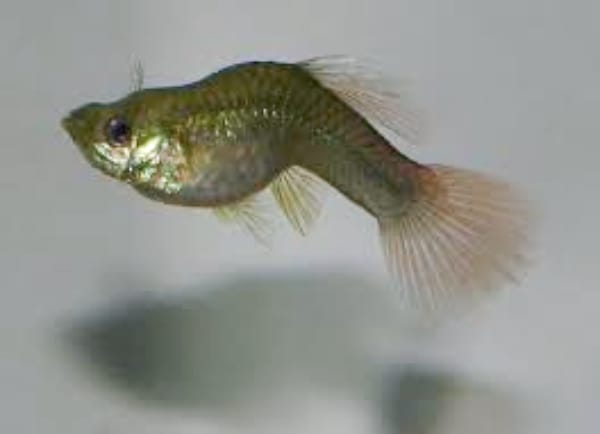
Humans are not the only creature on earth that can suffer from scoliosis or bent spine. Guppy fish can also suffer from this disease, and in fact, it is not a rare disease in guppies.
This condition is found in younger fish that appear to have a bent or crooked back. It is commonly caused by genetics or environmental factors. It is usually the result of in-breeding guppies and can be passed down to their offspring.
Guppies with scoliosis are often weaker, bullied by others, and suffer from swimming problems. They also have a slower growth rate and generally have shorter lifespans. While breeding scoliosis guppy fish is possible, it is not recommended.
Because it is mostly a genetic problem, this disease cannot be cured. It is not contagious but can be passed down to offspring. You don’t have to worry that it will not live long since guppies with scoliosis can still have a good life. All you need to do is give them a good diet and good water quality.
16. Dropsy
This guppy fish disease will make your fish appear to be bloated. It will make them difficult to swim and have other internal problems such as an infected kidney due to bacterial infection.
Sick fish will usually show signs of swollen body, discolored or distorted body, and elevated scales, which may look like pinecones.
Despite its cute name, dropsy is deadly to guppy fish. Once you spot this disease, it is usually too late to cure the fish. Therefore, it is better to prevent it from happening by ensuring regular care is done on your fish tank, and no water pollution occurs in it.
How to treat dropsy in guppy fish? Well, you cannot completely cure the disease. However, it can be slowed down by adding 2 tablespoons of Epsom salt to every 1 gallon of water.
Put the water in it for about 30-45 minutes. Also, make sure that the water has the same temperature as the water in the original tank.
17. Hexamitiasis in Guppy Fish
It is another disease caused by Hexamitia, a type of protozoan parasite. This parasite rarely occurs in guppies. However, it sometimes happens and can cause holes in the guppies’ heads.
Guppy fish with this parasite will often show white and stringy feces, pale colored bodies, lose appetite, and even refuse to eat. Here are a few steps to do to cure Hexamitiasis guppy:
- Use metronidazole to treat guppies with hexamitiasis.
- You can apply this medication through their food.
- If your guppy fish refuse to eat, add the metronidazole to the water instead. Add about 250mg metronidazole per 10 gallons of water once a day for 3 days minimum.
This disease is usually observed in overcrowded aquariums with inadequate filtration systems. The poor oxygen level and lack of water changes become factors of how Hexamitiasis can happen.
18. Fish Tuberculosis
Tuberculosis can also infect guppy fish, and it is caused by mycobacterium. This disease’s symptoms include lack of appetite, hollow-belly, an ulcer on the body or around the anus, discoloration, and rotting fin and tail.
Guppy fish that suffer from fish tuberculosis disease will become less active and will then slowly die. When your fish dies from tuberculosis, you need to remove it immediately because other fish in the tank that consume their remains will get infected. Tuberculosis can also be passed down to their offspring as well.
It is not easy to treat guppies with fish tuberculosis, although it is still possible. The most important thing to do is to remove the sick fish and quarantine them.
Then treat them with Neomycin, Kanamycin, or Isoniazid. However, if it does not show signs of improvement, then never return them to original tanks to prevent the bacteria’s spread.
It is also important to note that fish tuberculosis can also be passed to humans. Therefore, you have to be very careful when handling sick fish.
19. Guppy Constipation
How do you treat guppy constipation? First, you should know what causes it. One of the usual suspects of constipation in guppy fish is you either overfed them or they are allergic to a certain type of food.
It may seem like a small stomach issue but if it is untreated it can lead to death.
So, how to treat guppy constipation? Try feeding them with food that contains high fiber such as tinned peas. You can also try changing about 30% of your aquarium tank water and increasing the tank temperature to about 72-82 °F (22-28 °C).
Final Words
Those are some guppy fish diseases and how to treat those diseases that you need to know if you are planning to have them as a pet. There are also other diseases such as constipation in guppy fish that you should know.
Ensure you take care of them well and perform immediate medication or care when they show signs of diseases. This way, you will have happy and long-lived guppies.
